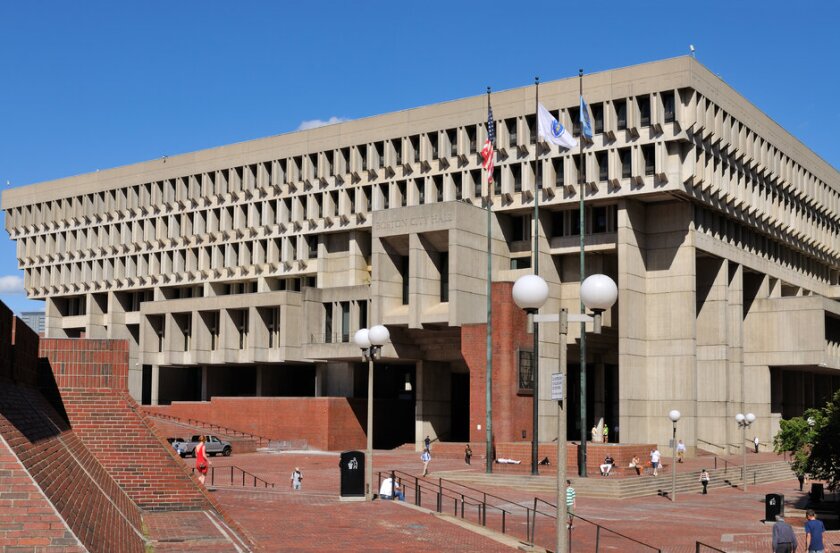Sometimes, Moynihan said this in rather fancier language. “If we are to restore to American public life the sense of shared experience, trust and common purpose that seems to be draining out of it,” Moynihan declared, "the quality of public design has got to be made a public issue because it is a political fact. It is not an efflorescence of elite aestheticism; it is the bone and muscle of democracy.”
Could any politician today use a phrase like “efflorescence of elite aestheticism,” without embarrassment? Probably not. Moynihan isn’t around to use it: He retired from the Senate in 2000 and died in 2003. But the subject is still relevant, particularly in the aftermath of the attacks on the U.S. Capitol building early this month.
The white columns and dome of the Capitol are iconic now, but there were passionate debates about their form at its inception. Those debates helped make both the building and our democracy more robust, Moynihan said.
In 1805, President Jefferson and architect Benjamin Latrobe politely argued whether the Capitol should be decorated with Corinthian or Doric columns. The top of a Doric column is relatively plain. The Corinthian is fancier, having scrolly leaves or vegetation at the top.
Jefferson, both an architect and a political theorist, thought the simpler type was more appropriate for the room where the House of Representatives, the legislative body closest to the people, would be meeting. Latrobe, through persistence, won the argument when he was appointed to rebuild the Capitol after the British burned it down in the War of 1812. The half-circle domed hall, now known as Statuary Hall, has columns of dark marble and lighter Corinthian tops. It is beautiful.
On Jan. 6, it was vandalized. Moynihan would have said that our democratic system was being vandalized as well.
Moynihan not only cared deeply about architecture and urban design, he made it a legislative priority. He was instrumental in aligning aspects of Washington, D.C., with the original plan of Pierre L’Enfant and the McMillan Plan of 1902. He helped fund construction of a new train hall in New York City, which opened a few weeks ago and bears his name. Moynihan thought that public buildings are vessels for the meaning we pour into them, and their character should be a subject of civic debate. No debate, no meaning.
Last month, President Trump signed an “Executive Order on Promoting Beautiful Federal Civic Architecture,” which attempts to make classical architecture -- i.e. columns and such -- the official style of new federal buildings. It attempts to discourage more contemporary architecture, whether that is crisp glass-and-steel 20th Century modernism or more recent curvy constructions.
“Classical and other traditional architecture, as practiced both historically and by today’s architects,” the order reads, “have proven their ability to meet . . . today’s functional, technical and sustainable needs. Their use should be encouraged instead of discouraged.”
In the December order, the Trump administration sought to sideline the Design Excellence Program established in 1994 under the General Services Administration, which has produced many public federal buildings in a variety of architectural styles.
But even those who like classical columns and recognize their power were critical of the government attempting to impose a single style on federal architecture.
Steven W. Semes, who teaches architecture at Notre Dame, wrotethat “those supporting the Executive Order . . . must accept responsibility for their gross miscalculation in thinking this authoritarian administration would be a suitable vehicle to promote classical architecture.”
Justin Shubow, president of the National Civic Art Society that helped draft Trump’s order, said presidents often have uneven or contradictory records and does not back away from continuing to endorse Trump’s order. The collective horror in response to the Jan. 6 attacks shows how powerful classical architecture is, Shubow insists.
“If the Capitol had been brutalist, no one would have claimed it was desecrated, or that it was a temple,” said Shubow, referring to the mid-20th Century style of blocky concrete buildings that many people dislike. People and politicians see the Capitol as sacred, Shubow says, “and that sacredness comes from the architecture.”

Boston's City Hall, an example of modern government architecture disdained by the Trump administration and which lacks the power of the classical style, according to Justin Shubow. (Shutterstock)
Incoming president Joe Biden could immediately undo Trump’s executive order. I think Jefferson, who embraced new technology, would be disturbed to find one particular architectural style being made preeminent. As Jefferson said, the world belongs to the living. I think Moynihan, although a fan of classical architecture, would agree with those sentiments.
As we watch the very columns of our democracy wobble, it’s not a bad thing to be reminded of the design of the Capitol building itself, and the ongoing conversation as to what our vessels of democracy should look like.
Alexandros Washburn, a former aide to Moynihan and a top architect and urban designer, introduced me some years back to the Jefferson and Latrobe debates, and Moynihan’s thoughts on them. While Moynihan never thought our democracy was literally dependent on a specific building, Washburn says, he would have recognized the danger when vandals invaded and defaced it, while elected legislators arguably tore at its deeper foundations with some of their rhetoric.
“What happened now at the Capitol is a simultaneous attack; both words and stones,” Washburn argues. “That is why it is so dangerous.”
Governing's opinion columns reflect the views of their authors and not necessarily those of Governing's editors or management.









